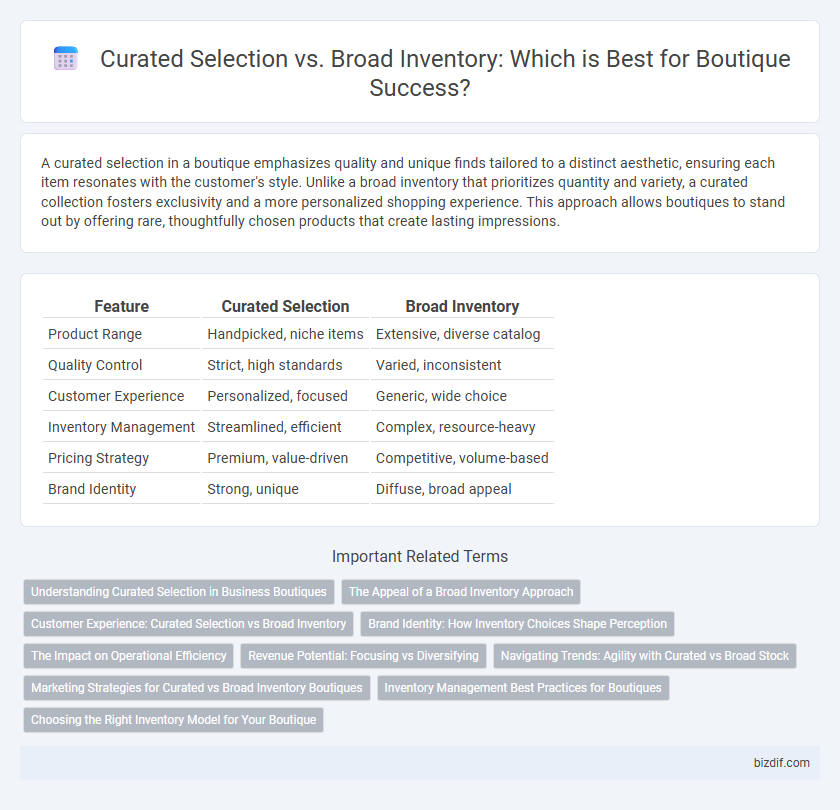A curated selection in a boutique emphasizes quality and unique finds tailored to a distinct aesthetic, ensuring each item resonates with the customer's style. Unlike a broad inventory that prioritizes quantity and variety, a curated collection fosters exclusivity and a more personalized shopping experience. This approach allows boutiques to stand out by offering rare, thoughtfully chosen products that create lasting impressions.
Table of Comparison
| Feature | Curated Selection | Broad Inventory |
|---|---|---|
| Product Range | Handpicked, niche items | Extensive, diverse catalog |
| Quality Control | Strict, high standards | Varied, inconsistent |
| Customer Experience | Personalized, focused | Generic, wide choice |
| Inventory Management | Streamlined, efficient | Complex, resource-heavy |
| Pricing Strategy | Premium, value-driven | Competitive, volume-based |
| Brand Identity | Strong, unique | Diffuse, broad appeal |
Understanding Curated Selection in Business Boutiques
Curated selection in business boutiques emphasizes a carefully chosen collection of high-quality, unique products tailored to the boutique's target audience, enhancing customer experience and brand identity. This approach contrasts with broad inventory strategies by prioritizing exclusivity, craftsmanship, and storytelling, which foster stronger emotional connections and repeat loyalty. Boutiques leveraging curated selections benefit from streamlined inventory management and the ability to command premium pricing by showcasing distinctive, thoughtfully sourced items.
The Appeal of a Broad Inventory Approach
A broad inventory approach in boutiques offers customers an extensive range of products, catering to diverse tastes and preferences, which enhances the likelihood of meeting individual needs. This strategy increases foot traffic by attracting a wider audience looking for variety and convenience under one roof. Retailers benefit from higher sales potential and the opportunity to cross-sell complementary items, driving overall revenue growth.
Customer Experience: Curated Selection vs Broad Inventory
A curated selection in boutiques enhances customer experience by offering carefully chosen, high-quality products that align with specific tastes and trends, fostering a sense of exclusivity and personalized service. In contrast, a broad inventory provides extensive variety, appealing to customers seeking one-stop shopping convenience and diverse options. Boutique customers often prefer the curated approach for its unique, focused appeal that simplifies decision-making and reinforces brand identity.
Brand Identity: How Inventory Choices Shape Perception
A curated selection in a boutique reinforces a distinct brand identity by emphasizing quality, exclusivity, and a cohesive aesthetic that resonates with target customers. In contrast, a broad inventory offers variety but may dilute the boutique's unique personality, making it harder to establish a memorable brand perception. Strategic inventory choices directly influence consumer perception, driving loyalty and differentiating the boutique in a competitive market.
The Impact on Operational Efficiency
A curated selection streamlines inventory management by reducing stock variety, which enhances operational efficiency and minimizes storage costs. Boutique stores with focused product offerings benefit from faster decision-making processes and simplified supply chains. In contrast, a broad inventory increases complexity, requiring more resources for tracking, replenishment, and quality control, ultimately impacting profitability.
Revenue Potential: Focusing vs Diversifying
Curated selections in boutiques enhance revenue potential by targeting niche markets with high-margin, exclusive products that attract dedicated customers willing to pay a premium. Broad inventories offer diversified revenue streams by appealing to a wider audience, increasing volume sales but often at lower margins. Focusing on a curated product range leverages brand identity and customer loyalty, while diversifying inventory mitigates risk through varied consumer preferences.
Navigating Trends: Agility with Curated vs Broad Stock
Boutiques capitalize on agile curated selections to swiftly adapt to emerging fashion trends, ensuring timely, exclusive offerings that resonate with niche markets. In contrast, broad inventories provide extensive variety but often struggle with rapid trend responsiveness due to larger stock volumes. Effective navigation of trends requires balancing the boutique's nimble curation with inventory scale to optimize customer engagement and relevance.
Marketing Strategies for Curated vs Broad Inventory Boutiques
Marketing strategies for curated selection boutiques emphasize exclusivity, storytelling, and personalized customer experiences to highlight unique, high-quality products. Broad inventory boutiques focus on mass appeal through competitive pricing, extensive product variety, and targeted advertising aimed at diverse consumer segments. Data-driven insights and customer segmentation enable curated boutiques to foster brand loyalty, while broad inventory stores leverage volume sales and frequent promotions for customer acquisition.
Inventory Management Best Practices for Boutiques
Boutiques thrive by balancing curated selection with broad inventory through strategic inventory management that prioritizes quality over quantity, enhancing customer experience and brand identity. Implementing real-time inventory tracking systems and demand forecasting tools optimizes stock levels, minimizes overstock risks, and reduces markdowns. Focusing on limited yet distinctive product ranges allows for personalized curation while maintaining flexible inventory turnover to meet seasonal trends and consumer preferences efficiently.
Choosing the Right Inventory Model for Your Boutique
Curated selection in a boutique enhances brand identity by offering a carefully chosen range of unique, high-quality products that appeal to a specific target market and foster customer loyalty. Broad inventory provides diverse options, catering to varied customer preferences and increasing the likelihood of meeting multiple needs within a single shopping experience. Choosing the right inventory model depends on factors such as boutique size, target demographic, supplier relationships, and the desired shopping experience to optimize sales and build a strong brand presence.
Curated Selection vs Broad Inventory Infographic

 bizdif.com
bizdif.com